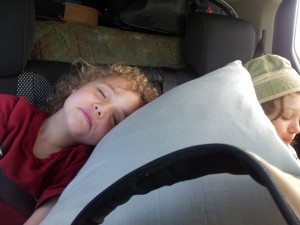I am very fortunate to have a child with autism who is a good traveler. We haven’t braved planes with him yet, but he does very well on public transportation and in the car. Even so, we have to put careful planning into lengthy drives to ensure that he stays safe and happy, and that the rest of the family survives with all their wits intact.
1. Make sure the child locks are engaged. Most neurotypical kids are aware of the dangers of opening the car door while the car is in motion. A kid with autism might tug on the door handle just to see what happens, without regard for the possible consequences. If you don’t know how to set the child locks, read the manual. If you’re in the market for a new car, check it out for safety features with your special needs child in mind.
2. Kids who have trouble with car travel should be eased into it gradually. If your child cannot get as far as the grocery store without melting down, don’t plan a road trip to the other end of the country. Experiment with a few trips of 30 minutes or so. During those trips, try different activities and snacks, until you figure out what works.
3. If you’re going on a long trip, plan your route to include stops at parks or play areas. We all benefit from getting out of the car and moving around from time to time, and it’s good for all kids to expend their energy. For kids with autism, there is an added consideration: those who are sensory-seeking may have a particularly difficult time sitting still in a car, so those activity breaks are often a necessity for them.
4. Some kids with autism cannot tolerate bright light. You might be able to make the trip a lot easier by investing in a shade for the window beside your child. The shades are easily applied with suction cups, and you might be able to leave it to your child to decide whether they are open or closed.
5. When deciding what to bring with you, stick with what you know your child likes. Buying a new toy especially for the trip may backfire. If your child stims by repeatedly stacking eight identical pieces of Lego, bring them along. If he reads the same book over and over, don’t leave that book at home. New stuff might create anxiety and frustration, whereas comfort can be found in the familiar items.
6. If you are planning to hit the road at night with the hope that your child will sleep, follow the usual bedtime routine immediately before you leave. It may still be a little disruptive, but your child will at least be geared for the idea of going to sleep. You may even get away with putting a smaller child to bed and then carrying him to the car once he’s gone to sleep.
7. Be prepared for the possibility of meltdowns. It can happen to the most accomplished of car travelers. If you use reinforcers (in our case, gummy bears), bring along a good supply. Think of your usual strategies for containing or diffusing meltdowns, and consider how you can modify them for use in a moving car (if you can stop, great – but you may not be able to pull over right away).
8. Don’t be 100% focused on the needs of your child with autism. The truth is that no matter how well prepared you are, unexpected things can happen. If you have taken the time to make sure everyone in the car has what they need for an enjoyable trip, the overall ambiance will be a lot more relaxed. That can make the world of difference to the child with autism, and to everybody else who is on the trip.
This is an original post by Kirsten Doyle, published in accordance with my disclosure policy. Photo credit to the author.











Autism is a disorder from childhood and children suffering from this must be handled with utmost care. The tips given above will be a great help to Autism families.